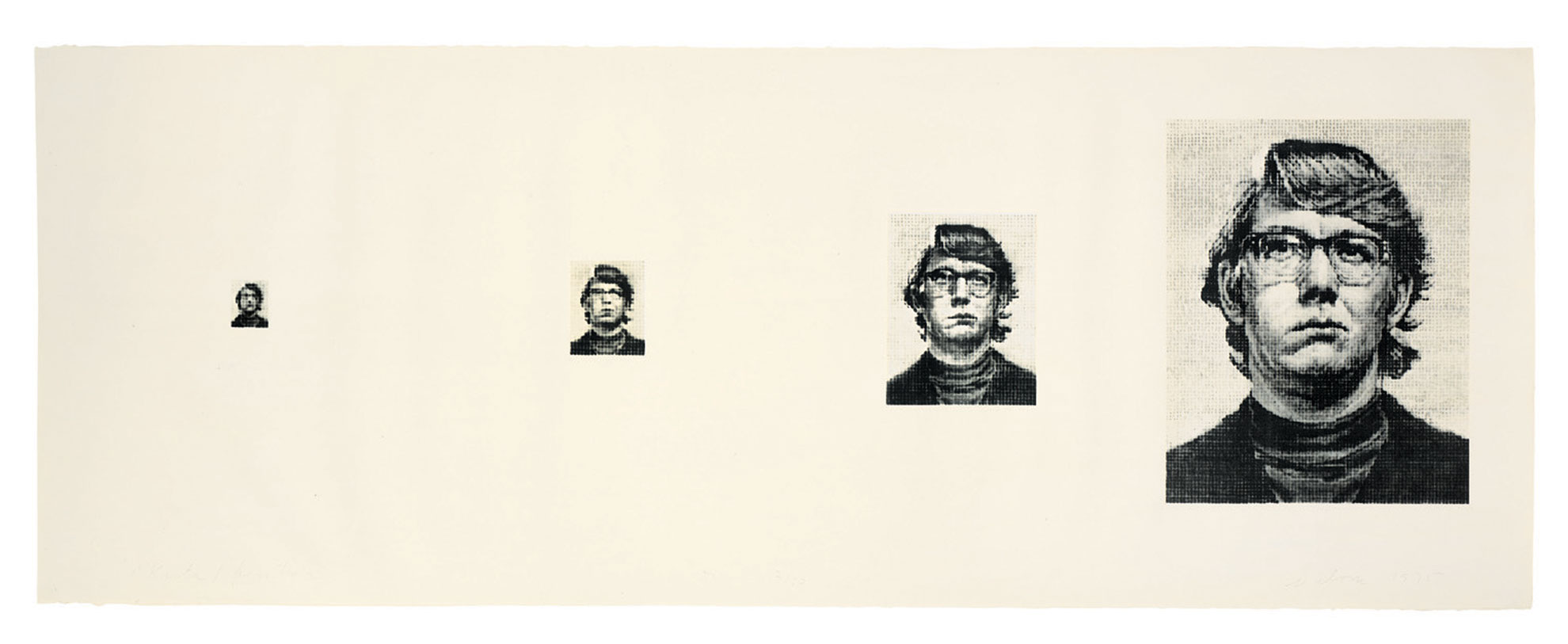Chuck Close Prints: Process and Collaboration

Chuck Close
Keith/Four Times, 1975
2-color lithograph from 8 stones
30 x 88"
Edition of 50
Landfall Press, Chicago, printer (Jack Lemon, David Keister)
Parasol Press, Ltd., New York, publisher
For more than thirty years, Chuck Close has explored the art of printmaking in his continuing investigation into the principles of perception. This exhibition is the first comprehensive survey of Close's involvement and accomplishment with the varied forms and processes of printmaking. Featuring approximately one hundred works dated from 1972 to 2002, Chuck Close Prints illustrates the artist's range of invention in etching, aquatint, lithography, handmade paper, direct gravure, silkscreen, traditional Japanese woodcut, and reduction linocut. Highlighting the creative processes and technical collaboration between the artist and master printers, the exhibition demonstrates how Close has consistently but variously challenged the accepted boundaries of the printmaking tradition. Taken together, these prints constitute a remarkable self-portrait of the creative drive, vision, and intellect of one of America's most important living artists.
Chuck Close was born in 1940 and grew up in Washington State. A precocious draftsman from an early age, he quickly mastered realistic techniques like drawing in perspective. As a young man he attended the well-known MFA program at Yale University, where his classmates included the sculptor Richard Serra and the sculptor and painter Nancy Graves. In the 1960s Close became known for his large-scale, hyper-realistic paintings of faces. Throughout his career he has continued to create images of faces, which he calls "heads," in a wide variety of sizes, styles, and media.
Close has commented that he considers a face to be a roadmap of human experience. His works are often self-portraits and portraits of his friends and family. In his work, the topology of the human face becomes a series of gridded abstractions that, when assembled in the eye of the viewer, create an imagistic whole. Celebrated as a quintessential painter and photographer, Close has also mastered the unique artistic language of printmaking, a process that requires a special degree of trust and cooperation between artist and technician. The self-portraits and portraits that make up the exhibition encompass the major forms of printmaking.
From the artist's ambitious first mezzotint, Keith (1972), to his recent pulp-paper multiples, this exhibition chronicles Close’s genius in the medium in which he has done his most exciting work. While the production of a painting can occupy Close for many months, it is not unusual for one print to take more than two years to complete, from conception to final edition. The relationship between Close and the master printers is key to the success of his prints, as the artist insists on a decidedly interactive approach to their creation. Close has remarked, "Like any corporation, I have the benefit of the brainpower of everyone who is working for me. . . . My prints have been truly collaborative, even though control is something that I give up reluctantly."
Terrie Sultan, curator of the exhibition, writes in her introduction to the exhibition catalogue, "This project is entitled Process and Collaboration because those two words are essential to any conversation with Close about his prints. The creative process is as important to him as the finished product, and these works strive to reveal the routes taken to get to them. Showing the progressive and state proofs here along with the editioned works demystifies the artist's decision-making process, allowing us to visualize how these complex images are made, how he was thinking when he made the mark."
Chuck Close
Keith/Four Times, 1975
2-color lithograph from 8 stones
30 x 88"
Edition of 50
Landfall Press, Chicago, printer (Jack Lemon, David Keister)
Parasol Press, Ltd., New York, publisher
